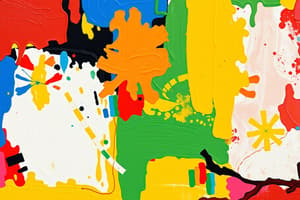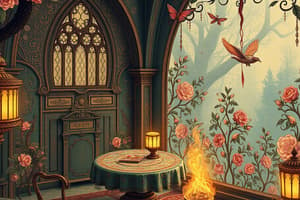Podcast
Questions and Answers
How many primary colors does the Prang system consist of?
How many primary colors does the Prang system consist of?
- 3 (correct)
- 4
- 5
- 2
What colors are considered the secondary colors in the Prang system?
What colors are considered the secondary colors in the Prang system?
- Red, blue, yellow
- Orange, green, violet (correct)
- Purple, cyan, magenta
- Red-orange, yellow-green, blue-violet
Which color is NOT classified as an intermediate color in the Prang system?
Which color is NOT classified as an intermediate color in the Prang system?
- Yellow-green
- Blue-green (correct)
- Red-violet
- Yellow-orange
What is the purpose of the Munsell system in relation to color classification?
What is the purpose of the Munsell system in relation to color classification?
Which hue is included in the Prang system but omitted from the Munsell system?
Which hue is included in the Prang system but omitted from the Munsell system?
How many fundamental colors are found at the outer rim of the Prang color wheel?
How many fundamental colors are found at the outer rim of the Prang color wheel?
Which color is found at the center of the Prang color wheel?
Which color is found at the center of the Prang color wheel?
Which of the following is NOT a principle hue in the Munsell system?
Which of the following is NOT a principle hue in the Munsell system?
What do coarse or rough textures commonly suggest about an object?
What do coarse or rough textures commonly suggest about an object?
How does the use of different textures affect color perception?
How does the use of different textures affect color perception?
What is the main focus area in a piece of artwork referred to as?
What is the main focus area in a piece of artwork referred to as?
What defines decorative space in painting?
What defines decorative space in painting?
Which term describes the third dimension's illusion in a painted artwork?
Which term describes the third dimension's illusion in a painted artwork?
What combination of materials would violate the harmony of texture in a building?
What combination of materials would violate the harmony of texture in a building?
Which method is NOT used to create an illusion of depth in artwork?
Which method is NOT used to create an illusion of depth in artwork?
What term describes the range of darkness or lightness of an object?
What term describes the range of darkness or lightness of an object?
What do horizontal lines typically express in visual art?
What do horizontal lines typically express in visual art?
Which type of shape is characterized by having a natural appearance?
Which type of shape is characterized by having a natural appearance?
What psychological impression does a large form typically convey?
What psychological impression does a large form typically convey?
What effect do curved lines generally suggest in art?
What effect do curved lines generally suggest in art?
How do vertical rectangles primarily affect visual perception?
How do vertical rectangles primarily affect visual perception?
What type of lines are likely to convey a sense of disorder?
What type of lines are likely to convey a sense of disorder?
Which statement accurately describes the difference between shapes and forms?
Which statement accurately describes the difference between shapes and forms?
Which geometric shape can typically suggest stability when presented as a rectangle?
Which geometric shape can typically suggest stability when presented as a rectangle?
What effect do darker values typically suggest in artwork?
What effect do darker values typically suggest in artwork?
Which colors are classified as primary colors?
Which colors are classified as primary colors?
What do lighter values commonly indicate in an artwork?
What do lighter values commonly indicate in an artwork?
How can you create a tint of a hue?
How can you create a tint of a hue?
What do contrasting values in artwork achieve?
What do contrasting values in artwork achieve?
Which of the following is a secondary color?
Which of the following is a secondary color?
What happens to the perception of a value when placed on a contrasting background?
What happens to the perception of a value when placed on a contrasting background?
What colors are combined to make intermediate colors?
What colors are combined to make intermediate colors?
What happens to a color when more yellow hue is added to it?
What happens to a color when more yellow hue is added to it?
How is a shade of a color produced?
How is a shade of a color produced?
What is the effect of using light colors on a ceiling in a room?
What is the effect of using light colors on a ceiling in a room?
Which statement is true about how values affect the perception of objects' size?
Which statement is true about how values affect the perception of objects' size?
What property of color does 'value' refer to?
What property of color does 'value' refer to?
What is a key characteristic of colors that have the same hue and value but different intensities?
What is a key characteristic of colors that have the same hue and value but different intensities?
Why is white on a black background more noticeable than black on a white background?
Why is white on a black background more noticeable than black on a white background?
What does intensity refer to in terms of color?
What does intensity refer to in terms of color?
Flashcards are hidden until you start studying
Study Notes
Prang Color System
- Color wheel with twelve fundamental colors:
- Three primaries: red, yellow, blue, located at the outer rim and forming an equilateral triangle
- Three secondaries: orange, green, violet, located between two primaries
- Six intermediates: red-orange, yellow-orange, yellow-green, blue-green, blue-violet, red-violet
- Each fundamental color is repeated towards the center of the color wheel, gradually becoming less intense and turning into grey at the center.
Munsell Color System
- Disregards the primaries and secondaries of Prang System
- Five principal hues: red, yellow, green, blue, purple
- Five intermediates
Psychological Effects of Colors
- Warm Colors: Yellow, orange, and red, create a sense of excitement and energy.
- Cool Colors: Blue, green, and purple, evoke calmness and tranquility.
- Intensity: Brightness or dullness of a color, affecting its perceived energy.
Shapes
- Two-dimensional representation of an object or idea
- Geometric shapes: squares, circles, triangles, rectangles, etc.
- Organic shapes: irregular, natural shapes like clouds, leaves, etc.
Form
- Three-dimensional object with height, width, and thickness.
- Forms vary in size, shapes, and texture.
- Objects should be seen as visual forms.
Psychological Effects of Forms and Shapes
- Large Forms: Sense of spaciousness and superiority.
- Small Forms: Sense of inferiority and crowding.
- Horizontal Rectangles: Stability, calmness, and a sense of "close set".
- Vertical Rectangles: Dignity, uprightness, and feeling of upward movement.
- Circular Shapes: Simplicity, continuity, and monotony.
Texture
- The way a surface feels or looks.
- Can be sensed by touch and sight.
- Described using words like rough, silky, pebbly, etc.
- Affects the color and perception of an object.
Psychological Effects of Texture
- Coarse/Rough: Strength, endurance, lower cost.
- Fine/Smooth: Excellent finish, delicateness, higher cost.
Space
- Empty area between, around, above, below, or within objects.
- Positive space: Main area or object of focus.
- Negative space: Everything else surrounding the focus.
- Space can create a feeling of three-dimensionality in two dimensional art.
- Smaller objects appear further away.
- Larger objects appear closer.
Psychological Effects of Value
- Dark Values: Quietness, dignity, suggest nearness and foreground.
- Light Values: Lightness, informality, suggest distance and background.
- Contrasting Values: Clarity, decision, emphasize each other.
- Closely Related Values: Quietness, rest, tend to merge.
Value
- The lightness or darkness of a color.
- Lighter values suggest light source or reflection.
- Darker values suggest the absence of light.
- Used to create a sense of depth in two-dimensional art.
- Affects the mood: lighter values suggest happiness, darker values suggest sadness.
Color
- Perceived when light waves strike the eye.
- Dependent on light.
Color Properties
- Primary Colors: Red, yellow, blue, cannot be mixed from other colors.
- Secondary Colors: Green, orange, purple, created by mixing two primary colors.
- Intermediate Colors: Combine a primary and a secondary color.
- Warm Colors: Yellow, orange, red, often associated with energy and excitement.
- Cool Colors: Blue, green, purple, associated with calmness and tranquility.
Intensity
- Brightness or dullness of a color, affecting its perceived energy.
Tints and Shades
- Tints: Lighter versions of a color created by adding white pigment.
- Shades: Darker versions of a color created by adding black pigment.
Studying That Suits You
Use AI to generate personalized quizzes and flashcards to suit your learning preferences.




